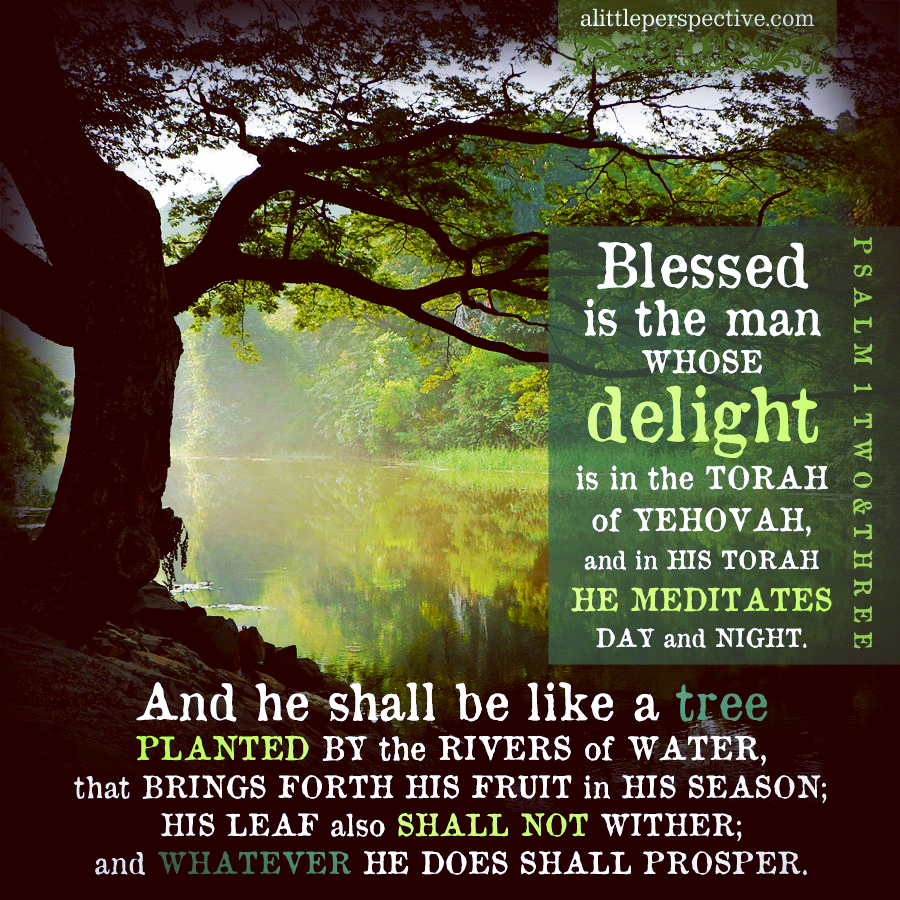Read Psalm 1 at Bible Gateway.
The Psalms contain paragraph divisions similarly as the Torah does:
“We have added signs for the paragraphs found in the original Hebrew: In the poetical books of Psalms, Job (aside from the beginning and end), and Proverbs, each verse normally starts on a new line; where there is a new line within a verse, we added {N}, and when there is a blank line, we added {P}.” Hebrew Bible in English
In the Torah, the stumah or weak paragraph division roughly corresponds to the new line of the poetical books, and the p’tuchah or strong paragraph division roughly corresponds to the blank line of the poetical books. In the Psalms, I am using HBE markings of {n} and {p} to indicate weak and strong divisions.
Psalm 1 paragraph divisions
Psa 1:1a, Happy is the man that hath not walked in the counsel of the wicked; {n}
Psa 1:1b, Nor stood in the way of sinners, nor sat in the seat of the scornful;
Psa 1:2, But his delight is in the torah of Yehovah; and in His torah doth he meditate day and night;
Psa 1:3a, And he shall be like a tree planted by streams of water; {n}
Psa 1:3b, That brings forth its fruit in its season, whose leaf does not wither; in whatever he does he shall prosper;
Psa 1:4, Not so the wicked; but they are like the chaff which the wind drives away;
Psa 1:5, Therefore the wicked shall not stand in the judgment, nor sinners in the congregation of the righteous;
Psa 1:6, For Yehovah regards the way of the righteous; but the way of the wicked shall perish. {p}
Psalm 1 chiastic structure
1a) Psa 1:1-2, The contrast between the righteous and wicked;
1) Psa 1:1, Blessed is the man who walks not {n} + stands not + sits not with wicked + sinners + scornful;
2) Psa 1:2, But his delight is in the Torah of Yehovah in which he meditates day + night;
1b) Psa 1:3a The righteous are like a tree planted by the rivers of water {n};
1c) Psa 1:3b, That brings forth its fruit in its season;
central axis) Psa 1:3c, Whose leaf also does not wither;
2c) Psa 1:3d, And whatever he does shall prosper;
2b) Psa 1:4, The wicked are like the chaff which the wind drives away;
2a) Psa 1:5-6, The contrast between the righteous and wicked;
1) Psa 1:5, The wicked shall not stand in the judgment nor sinners counted among the congregation;
2) Psa 1:6, Yehovah regards the way of the righteous, but the way of the wicked shall perish {p}.
Psalm 1 is reiterating what we have already seen in Torah, that Torah obedience brings about blessing in this life for the natural man. The central axis and its surrounding elements describe the prosperity of the righteous.
In the Psalms, there is not a distinction between the righteous who are in right- standing before God by grace through faith (the justified or saved) and the righteous who are deemed so because of their righteous deeds (the sanctified). In the New Testament, one kind of righteousness (justification) is a result of faith, and the other kind of righteousness (sanctification) is a result of works. Paul made this distinction in the New Testament in order to explain salvation to Gentiles. However, throughout the Hebrew Bible, the two are simply regarded as the single “righteousness.” God accounts righteousness to the circumcised heart before Him, the heart which believes in God and believes the truth of God’s words. This is the righteousness that is of faith: salvation or justification. This righteousness, however, always produces the corresponding righteous deeds lived out in the life: sanctification. Faith and works are not really enemies or opposites. ♥
The A pair was especially interesting to me. The righteous man has regard for the Torah (way) of Yehovah, and meditates in it day and night. Yehovah then has regard for the way of the righteous. We will see this reciprocal relationship between Yehovah and the righteous man, who delights in Yehovah, expressed throughout the Psalms.
For further study
psalm 1, two trees, two ways 2011 jan 01

















Leave a Reply